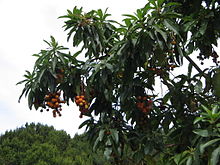Arbutus canariensis, known in Spanish as madroño canario, is a species of shrub or tree in the heath family. It is endemic to the Canary Islands of Spain, specifically Tenerife, La Gomera, Gran Canaria, El Hierro, and La Palma. It is threatened by habitat loss.[1]
| Arbutus canariensis | |
|---|---|

| |
| Scientific classification | |
| Kingdom: | Plantae |
| Clade: | Tracheophytes |
| Clade: | Angiosperms |
| Clade: | Eudicots |
| Clade: | Asterids |
| Order: | Ericales |
| Family: | Ericaceae |
| Genus: | Arbutus |
| Species: | A. canariensis
|
| Binomial name | |
| Arbutus canariensis Veillard ex Duhamel 1800
| |
| Synonyms[2] | |
| |
Hybrids edit
Arbutus x thuretiana Demoly is a hybrid between A. canariensis and A. andrachne.[3] Named after Gustave Thuret, it is naturalised at Jardin botanique de la Villa Thuret.[4] A. x thuretiana is renowned for its perfectly smooth, reddish-brown bark, exfoliating in the spring to show a new, surprisingly pistachio-green bark, which gradually darkens and turns reddish again.[3]
Gallery edit
- Different parts of Arbutus canariensis and its hybrid
-
Foliage
-
Flowers
-
Fruits
-
Bark
-
Flowers of the hybrid Arbutus x thuretiana
References edit
- ^ a b Beech, E. (2017). "Arbutus canariensis". IUCN Red List of Threatened Species. 2017: e.T30322A81768520. doi:10.2305/IUCN.UK.2017-3.RLTS.T30322A81768520.en. Retrieved 16 November 2021.
- ^ The Plant List, Arbutus canariensis Duhamel
- ^ a b Filippi, Olivier (2007). Pour un jardin sans arrosage (For a garden without irrigation) (in French). Arles: Actes Sud. p. 80. ISBN 978-2-7427-6730-4.
- ^ Ducatillon, Catherine; Bellanger, Richard; Charron, Tristan; Chevallier, Joelle; Heinz, Christine; Marchal, Cecilia; Mellerin, Yannick; Caraglio, Yves; Ameglio, Thierry (2018), "Study of the adaptability of trees to drought:phenological monitoring of assisted growth sensors, in the Botanical Garden of Villa Thuret", Proceedings of the EuroGard VII Congress, vol. VII, EUROGARD, pp. 322–331, retrieved 2020-03-23
External links edit
- Wildscreen Arkive
- National Arboretum Canberra (Australia), Arbutus canariensis, Canary Madrone Archived 2020-03-21 at the Wayback Machine photos and informal information
- UK Wildflowers, Arbutus canariensis, Canary Islands Strawberry Tree photos
- Useful Tropical Plants, Arbutus canariensis Images high-quality photos
Wikimedia Commons has media related to Arbutus canariensis.
